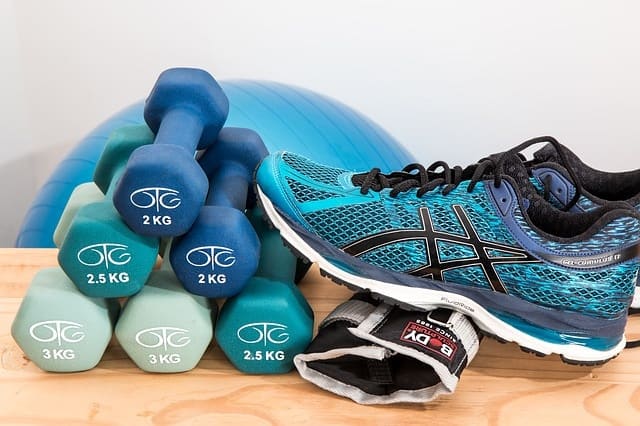Let’s first clarify that we are talking about “fat” loss, not “weight” loss:
What is the difference? Simply put, weight loss can be due to the loss of body fat, water, or muscle tissue. Whereas fat loss is the loss or reduction of one’s body fat.
Oftentimes, going on a very low-carb diet and increasing amounts of cardio will result in weight loss. However, most of the initial weight loss is just water loss:
Related: 10 Best Cooking Shows On Hulu
Maintaining a low-carb diet as well as continuously increasing cardio is not sustainable. For most, this is the reason why weight is regained when carbs are reintroduced.
So how do you lose and maintain fat loss? Here are 8 tips to help you get started:
1. Eat More Protein
When you eat protein, your body goes through a process called thermogenesis. This process requires the body to expend more energy in order to digest food. This in turn helps you feel full, satisfied, and less likely to binge on junk foods. A high protein intake can help boost metabolism, lower blood pressure, and increase muscle mass.
Also Read: How To Get Fantastic-Toned Arms With Push-Ups
2. Lift Weights
Studies show that a well-designed strength training program can elevate your EPOC or “Excess Post-Exercise Oxygen Consumption,” for up to 38 hours after your workout. In other words, you continue to burn calories long after you train.
Strength training, coupled with diet and cardio, burns fat far more than cardio and diet alone.
Be sure to prioritize compound lifts in your training. Compound lifts like the squat, bench press, deadlift, bent-over row, and shoulder press, require you to use multiple muscle groups at the same time.
Performing these lifts will allow you to lift more weight, engage more muscles, and increase your metabolic rate. Compound lifts are ideal for building muscle and burning fat.
Also Read: Why You Can’t Exercise A Poor Diet
3. Don’t Drink Your Calories
Sugary drinks such as sodas and juices have anywhere between 110-140 calories or more, and about 21-40g of sugar per serving size!
This high amount of sugar, carbs, and calories can add up fast and easily put you in a caloric surplus. Not to mention, a can of soda or glass of juice will not fill you up the way nutritionally dense food will.
Opt for more water and more healthy food.
4. De-Stress
Stress can trigger the adrenal glands to produce cortisol, also known as the “stress hormone.” High cortisol levels increase appetite and drive abdominal fat storage.
Help reduce belly fat by engaging in more pleasurable activities that relieve stress. Practicing yoga or meditation can also be an effective method.
Also Read: Transform Your Diet In 10 Easy Steps
5. Get Enough Sleep
Getting enough quality sleep is important and should not be neglected. In the short term, a lack of adequate sleep can affect:
- Judgment
- Mood
- Ability to learn and retain information
- May increase the risk of serious accidents and injury.
In the long term, chronic sleep deprivation may lead to a host of health problems including:
- Obesity
- Diabetes
- Cardiovascular disease
- Even early mortality
Shoot for 7-8 hours of sleep per night.
6. Limit Processed Foods
Eat real food instead. Processed junk food has led to an increase in obesity in both adults and children. These foods trick our brains into eating more than we need (due to the lack of nutrients).
They are low in fiber, protein, and micronutrients (empty calories), but high in unhealthy ingredients like added sugar and refined grains.
Related: 10 Worst Foods For The Lymphatic System
7. Don’t Completely Ditch Carbs
Your body needs carbohydrates!
Fad diets that completely cut out carbs can be dangerous and fail to teach you anything about fueling your body. Remember “reducing” the number of carbs you eat will help you lose weight. Not cutting out carbs completely.
Carbs are the body’s main source of energy, helping your body to preserve muscle. They’re important for brain function and the operation of the organs. They help regulate blood glucose and the breakdown of fatty acids. Carbs contain essential dietary fiber, and every cell and tissue in the body needs carbs.
It’s important to choose the right type of carbs, which contain vitamins, minerals, and fiber. Such as whole grains, fresh fruit, vegetables, sweet potatoes, oats, legumes, and milk.
Also Read: Help Your Kids Maintain A Healthy Lifestyle
8. Don’t Fall For The Latest Diet Trend
Old and new diet fads promise the best results in the least amount of time. Yes, they can work if followed correctly… But then what?
When the diet’s over people tend to regain the weight they’ve lost (plus more). Your weight continually yo-yo’s and so does your relationship with food!
Losing weight and maintaining a healthy body weight takes effort, time, and patience. Fad diets are not sustainable. Eat healthy, balanced, and stay active! You will see better, long-lasting results.
So, now that you know the difference between weight loss and fat loss, we can now start applying these 8 fat loss tips. Implementing these tips will help you lead a healthier lifestyle, lose weight, and keep it off!
Shirlee is driven by her passion for dance, movement, fitness, health, and energy. She became an American College of Sports Medicine (ACSM) certified personal trainer. She is dedicated to providing motivation and goal-driven programs and looks forward to helping clients become happy and healthy inside and out. Hybridbarbell.com

